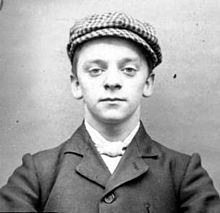peaky blinder
Jump to navigation
Jump to search
English
[edit]
Etymology
[edit]From the name of a street gang in Birmingham, the Peaky Blinders, who got their name From the peaked caps their members wore, and from blinder (“exceptional performance”) or from the practice of pulling a victims hat over his eyes so that he could not identify his attacker. There is a folk etymology claiming the "blinder" part of the name comes from the practice of stitching razor blades or weights into the peak of the cap and using it as a weapon to blind one's opponent, but this has been shown to be apocryphal.
Noun
[edit]peaky blinder (plural peaky blinders)
- (historical) A member of the Peaky Blinders gang. They operated in Birmingham from the end of the 19th century until after the First World War. Gang members had a distinctive appearance: close-cropped hair, bell-bottomed trousers, peaked caps, and a white scarf knotted at the throat.
- 1910, Robert Hall Best, William John Davis, Charles Perks, The Brassworkers of Berlin and of Birmingham: A Comparison, page 35:
- They return from camp with new boots, shirt, stockings and money; part of which is spent in excess on their first night's return after training and part goes to purchase a pair of “peaky blinder” trousers.
- 1984, Midland History - Volumes 9-12, page 108:
- In Birmingham the 'peaky-blinder' and 'slogger' gangs were particularly notorious.
- 2019, Carl Chinn, Peaky Blinders - The Real Story of Birmingham's most notorious gangs.:
- There is a reference in the Birmingham Daily Gazette to a 'hooligan outrage' in Newton Row in January 1907 - which had formerly been a peaky blinder stronghold - when three men of the peaky blinder type savagely attacked and robbed a businessman late at night, but there appears to be no mention of assaults or fights by peaky blinders after that..
- 2016, Dick Hobbs, Mischief, Morality and Mobs, page 94:
- As Arthur Matthison recalled (1937:63), the peaky blinder wore: Bell-bottomed trousers secured by a buckle belt, hob-nailed boots, a jacket of sorts, a gaudy scarf and a billy-cock hat with a long elongated brim.
- (archaic) A peaked cap like that worn by a peaky blinder, especially when worn with the peak pulled down to the side of the head.
- 1899, The Puritan - Volume 5, page 206:
- So, in London, birds of a feather must flock together, willy nilly, silk hat and frock coat must go with white gloves and brown sables, “peaky blinder and “ choker " must associate with crop fringed hair, ear curls, and rakish three feathered hat.
- 1968, Maurice Wiggin, The Memoirs of a Maverick, page 30:
- You could practically hear the rusty wheels whirring round beneath his black peaky blinder.
- 2019, Carl Chinn, Peaky Blinders - The Real Story of Birmingham's most notorious gangs.:
- The peak of the peaky-blinder was usually slit open and pennies or razor-blades or pieces of slate inserted and stitched up again. The caps, peaky-blinders, were used in fighting to be whipped off the head and swiped across the opponent's eyes, momentarily blinding them or slashing the cheeks.
- (Birmingham) Any ruffian or street gang member.
- 1908, The Spectator - Volume 101, page 781:
- Probably the "hooligan" of London need not cost more to redeem than the " ike " of Manchester or the "peaky blinder" of Birmingham; the differences in expense lie in the method.
- 1914, Pharmaceutical Journal - Volume 37, page 262:
- Hundreds of girls and youths, mainly of the “ peaky blinder ” type, parade the streets—sometimes half a dozen arm-in-arm across the pavements.
- 2019, Carl Chinn, Peaky Blinders - The Real Story of Birmingham's most notorious gangs.:
- There is a reference in the Birmingham Daily Gazette to a 'hooligan outrage' in Newton Row in January 1907 - which had formerly been a peaky blinder stronghold - when three men of the peaky blinder type savagely attacked and robbed a businessman late at night, but there appears to be no mention of assaults or fights by peaky blinders after that..
- 1964, Charles Frederick Victor Smout, The story of the progress of medicine, page 137:
- Nights on the district were nightmares. Peaky-blinder warrens down which the police daren't venture, except in twos; drunken gamp midwives under the bed, and often a race betwen half-an-inch of a guttering candle and a dawn two hours away, the patient indulging in a P.P.H., little or no water and no one to send for help.